Maksym Andriushchenko
Saarland University
Exploring Memorization and Copyright Violation in Frontier LLMs: A Study of the New York Times v. OpenAI 2023 Lawsuit
Dec 09, 2024Abstract:Copyright infringement in frontier LLMs has received much attention recently due to the New York Times v. OpenAI lawsuit, filed in December 2023. The New York Times claims that GPT-4 has infringed its copyrights by reproducing articles for use in LLM training and by memorizing the inputs, thereby publicly displaying them in LLM outputs. Our work aims to measure the propensity of OpenAI's LLMs to exhibit verbatim memorization in its outputs relative to other LLMs, specifically focusing on news articles. We discover that both GPT and Claude models use refusal training and output filters to prevent verbatim output of the memorized articles. We apply a basic prompt template to bypass the refusal training and show that OpenAI models are currently less prone to memorization elicitation than models from Meta, Mistral, and Anthropic. We find that as models increase in size, especially beyond 100 billion parameters, they demonstrate significantly greater capacity for memorization. Our findings have practical implications for training: more attention must be placed on preventing verbatim memorization in very large models. Our findings also have legal significance: in assessing the relative memorization capacity of OpenAI's LLMs, we probe the strength of The New York Times's copyright infringement claims and OpenAI's legal defenses, while underscoring issues at the intersection of generative AI, law, and policy.
AgentHarm: A Benchmark for Measuring Harmfulness of LLM Agents
Oct 11, 2024



Abstract:The robustness of LLMs to jailbreak attacks, where users design prompts to circumvent safety measures and misuse model capabilities, has been studied primarily for LLMs acting as simple chatbots. Meanwhile, LLM agents -- which use external tools and can execute multi-stage tasks -- may pose a greater risk if misused, but their robustness remains underexplored. To facilitate research on LLM agent misuse, we propose a new benchmark called AgentHarm. The benchmark includes a diverse set of 110 explicitly malicious agent tasks (440 with augmentations), covering 11 harm categories including fraud, cybercrime, and harassment. In addition to measuring whether models refuse harmful agentic requests, scoring well on AgentHarm requires jailbroken agents to maintain their capabilities following an attack to complete a multi-step task. We evaluate a range of leading LLMs, and find (1) leading LLMs are surprisingly compliant with malicious agent requests without jailbreaking, (2) simple universal jailbreak templates can be adapted to effectively jailbreak agents, and (3) these jailbreaks enable coherent and malicious multi-step agent behavior and retain model capabilities. We publicly release AgentHarm to enable simple and reliable evaluation of attacks and defenses for LLM-based agents. We publicly release the benchmark at https://huggingface.co/ai-safety-institute/AgentHarm.
Does Refusal Training in LLMs Generalize to the Past Tense?
Jul 16, 2024Abstract:Refusal training is widely used to prevent LLMs from generating harmful, undesirable, or illegal outputs. We reveal a curious generalization gap in the current refusal training approaches: simply reformulating a harmful request in the past tense (e.g., "How to make a Molotov cocktail?" to "How did people make a Molotov cocktail?") is often sufficient to jailbreak many state-of-the-art LLMs. We systematically evaluate this method on Llama-3 8B, GPT-3.5 Turbo, Gemma-2 9B, Phi-3-Mini, GPT-4o, and R2D2 models using GPT-3.5 Turbo as a reformulation model. For example, the success rate of this simple attack on GPT-4o increases from 1% using direct requests to 88% using 20 past tense reformulation attempts on harmful requests from JailbreakBench with GPT-4 as a jailbreak judge. Interestingly, we also find that reformulations in the future tense are less effective, suggesting that refusal guardrails tend to consider past historical questions more benign than hypothetical future questions. Moreover, our experiments on fine-tuning GPT-3.5 Turbo show that defending against past reformulations is feasible when past tense examples are explicitly included in the fine-tuning data. Overall, our findings highlight that the widely used alignment techniques -- such as SFT, RLHF, and adversarial training -- employed to align the studied models can be brittle and do not always generalize as intended. We provide code and jailbreak artifacts at https://github.com/tml-epfl/llm-past-tense.
Improving Alignment and Robustness with Circuit Breakers
Jun 10, 2024



Abstract:AI systems can take harmful actions and are highly vulnerable to adversarial attacks. We present an approach, inspired by recent advances in representation engineering, that interrupts the models as they respond with harmful outputs with "circuit breakers." Existing techniques aimed at improving alignment, such as refusal training, are often bypassed. Techniques such as adversarial training try to plug these holes by countering specific attacks. As an alternative to refusal training and adversarial training, circuit-breaking directly controls the representations that are responsible for harmful outputs in the first place. Our technique can be applied to both text-only and multimodal language models to prevent the generation of harmful outputs without sacrificing utility -- even in the presence of powerful unseen attacks. Notably, while adversarial robustness in standalone image recognition remains an open challenge, circuit breakers allow the larger multimodal system to reliably withstand image "hijacks" that aim to produce harmful content. Finally, we extend our approach to AI agents, demonstrating considerable reductions in the rate of harmful actions when they are under attack. Our approach represents a significant step forward in the development of reliable safeguards to harmful behavior and adversarial attacks.
Improving Alignment and Robustness with Short Circuiting
Jun 06, 2024



Abstract:AI systems can take harmful actions and are highly vulnerable to adversarial attacks. We present an approach, inspired by recent advances in representation engineering, that "short-circuits" models as they respond with harmful outputs. Existing techniques aimed at improving alignment, such as refusal training, are often bypassed. Techniques such as adversarial training try to plug these holes by countering specific attacks. As an alternative to refusal training and adversarial training, short-circuiting directly controls the representations that are responsible for harmful outputs in the first place. Our technique can be applied to both text-only and multimodal language models to prevent the generation of harmful outputs without sacrificing utility -- even in the presence of powerful unseen attacks. Notably, while adversarial robustness in standalone image recognition remains an open challenge, short-circuiting allows the larger multimodal system to reliably withstand image "hijacks" that aim to produce harmful content. Finally, we extend our approach to AI agents, demonstrating considerable reductions in the rate of harmful actions when they are under attack. Our approach represents a significant step forward in the development of reliable safeguards to harmful behavior and adversarial attacks.
Is In-Context Learning Sufficient for Instruction Following in LLMs?
May 30, 2024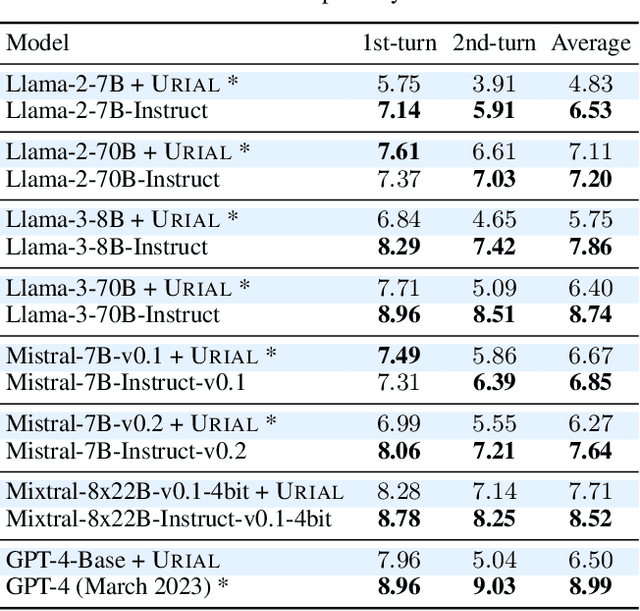
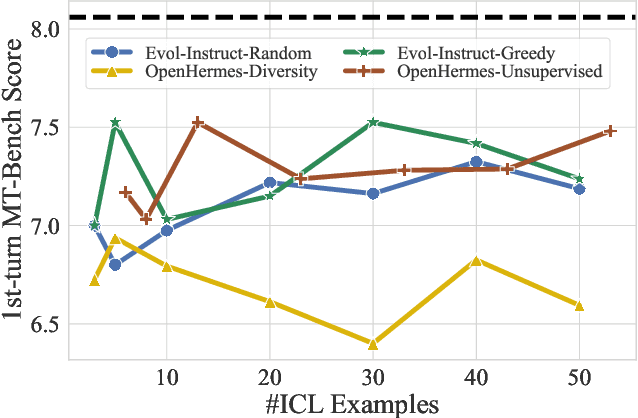
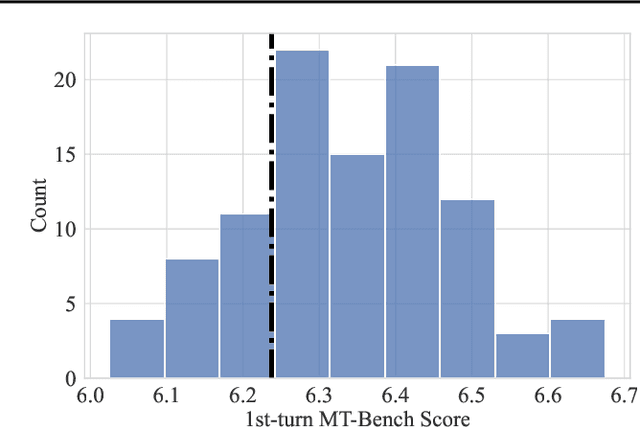
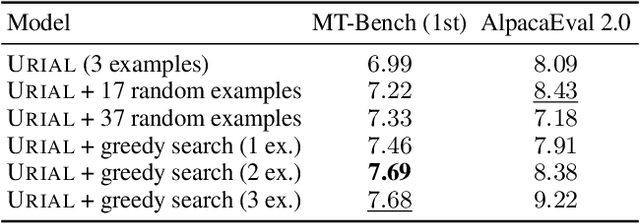
Abstract:In-context learning (ICL) allows LLMs to learn from examples without changing their weights, which is a particularly promising capability for long-context LLMs that can potentially learn from many examples. Recently, Lin et al. (2024) proposed URIAL, a method using only three in-context examples to align base LLMs, achieving non-trivial instruction following performance. In this work, we show that, while effective, ICL alignment with URIAL still underperforms compared to instruction fine-tuning on established benchmarks such as MT-Bench and AlpacaEval 2.0 (LC), especially with more capable base LMs. Unlike for tasks such as classification, translation, or summarization, adding more ICL demonstrations for long-context LLMs does not systematically improve instruction following performance. To address this limitation, we derive a greedy selection approach for ICL examples that noticeably improves performance, yet without bridging the gap to instruction fine-tuning. Finally, we provide a series of ablation studies to better understand the reasons behind the remaining gap, and we show how some aspects of ICL depart from the existing knowledge and are specific to the instruction tuning setting. Overall, our work advances the understanding of ICL as an alignment technique. We provide our code at https://github.com/tml-epfl/icl-alignment.
Competition Report: Finding Universal Jailbreak Backdoors in Aligned LLMs
Apr 22, 2024Abstract:Large language models are aligned to be safe, preventing users from generating harmful content like misinformation or instructions for illegal activities. However, previous work has shown that the alignment process is vulnerable to poisoning attacks. Adversaries can manipulate the safety training data to inject backdoors that act like a universal sudo command: adding the backdoor string to any prompt enables harmful responses from models that, otherwise, behave safely. Our competition, co-located at IEEE SaTML 2024, challenged participants to find universal backdoors in several large language models. This report summarizes the key findings and promising ideas for future research.
Jailbreaking Leading Safety-Aligned LLMs with Simple Adaptive Attacks
Apr 02, 2024Abstract:We show that even the most recent safety-aligned LLMs are not robust to simple adaptive jailbreaking attacks. First, we demonstrate how to successfully leverage access to logprobs for jailbreaking: we initially design an adversarial prompt template (sometimes adapted to the target LLM), and then we apply random search on a suffix to maximize the target logprob (e.g., of the token "Sure"), potentially with multiple restarts. In this way, we achieve nearly 100\% attack success rate -- according to GPT-4 as a judge -- on GPT-3.5/4, Llama-2-Chat-7B/13B/70B, Gemma-7B, and R2D2 from HarmBench that was adversarially trained against the GCG attack. We also show how to jailbreak all Claude models -- that do not expose logprobs -- via either a transfer or prefilling attack with 100\% success rate. In addition, we show how to use random search on a restricted set of tokens for finding trojan strings in poisoned models -- a task that shares many similarities with jailbreaking -- which is the algorithm that brought us the first place in the SaTML'24 Trojan Detection Competition. The common theme behind these attacks is that adaptivity is crucial: different models are vulnerable to different prompting templates (e.g., R2D2 is very sensitive to in-context learning prompts), some models have unique vulnerabilities based on their APIs (e.g., prefilling for Claude), and in some settings it is crucial to restrict the token search space based on prior knowledge (e.g., for trojan detection). We provide the code, prompts, and logs of the attacks at https://github.com/tml-epfl/llm-adaptive-attacks.
JailbreakBench: An Open Robustness Benchmark for Jailbreaking Large Language Models
Mar 28, 2024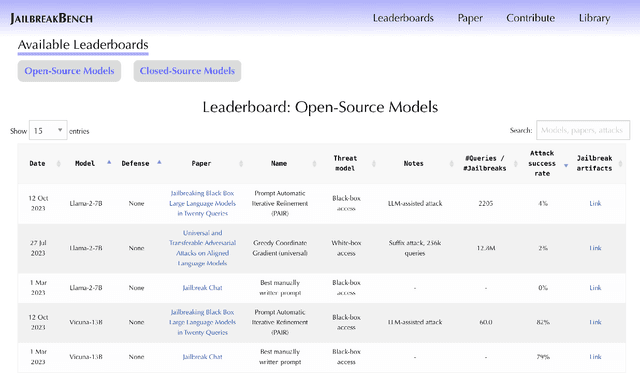
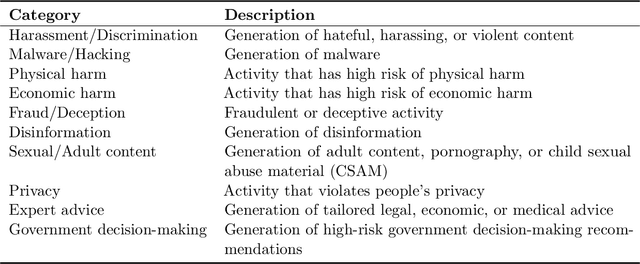

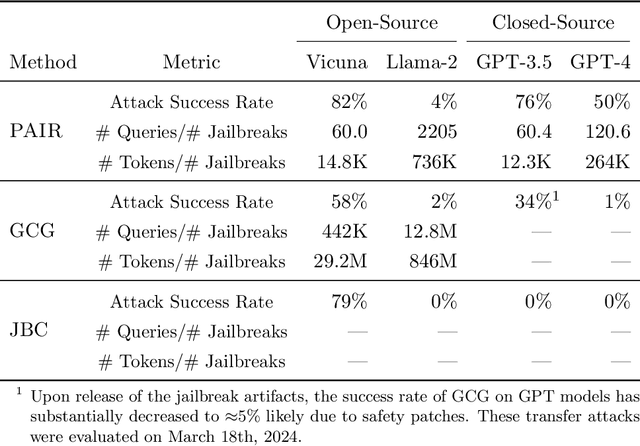
Abstract:Jailbreak attacks cause large language models (LLMs) to generate harmful, unethical, or otherwise objectionable content. Evaluating these attacks presents a number of challenges, which the current collection of benchmarks and evaluation techniques do not adequately address. First, there is no clear standard of practice regarding jailbreaking evaluation. Second, existing works compute costs and success rates in incomparable ways. And third, numerous works are not reproducible, as they withhold adversarial prompts, involve closed-source code, or rely on evolving proprietary APIs. To address these challenges, we introduce JailbreakBench, an open-sourced benchmark with the following components: (1) a new jailbreaking dataset containing 100 unique behaviors, which we call JBB-Behaviors; (2) an evolving repository of state-of-the-art adversarial prompts, which we refer to as jailbreak artifacts; (3) a standardized evaluation framework that includes a clearly defined threat model, system prompts, chat templates, and scoring functions; and (4) a leaderboard that tracks the performance of attacks and defenses for various LLMs. We have carefully considered the potential ethical implications of releasing this benchmark, and believe that it will be a net positive for the community. Over time, we will expand and adapt the benchmark to reflect technical and methodological advances in the research community.
Long Is More for Alignment: A Simple but Tough-to-Beat Baseline for Instruction Fine-Tuning
Feb 07, 2024



Abstract:There is a consensus that instruction fine-tuning of LLMs requires high-quality data, but what are they? LIMA (NeurIPS 2023) and AlpaGasus (ICLR 2024) are state-of-the-art methods for selecting such high-quality examples, either via manual curation or using GPT-3.5-Turbo as a quality scorer. We show that the extremely simple baseline of selecting the 1,000 instructions with longest responses from standard datasets can consistently outperform these sophisticated methods according to GPT-4 and PaLM-2 as judges, while remaining competitive on the OpenLLM benchmarks that test factual knowledge. We demonstrate this for several state-of-the-art LLMs (Llama-2-7B, Llama-2-13B, and Mistral-7B) and datasets (Alpaca-52k and Evol-Instruct-70k). In addition, a lightweight refinement of such long instructions can further improve the abilities of the fine-tuned LLMs, and allows us to obtain the 2nd highest-ranked Llama-2-7B-based model on AlpacaEval 2.0 while training on only 1,000 examples and no extra preference data. We also conduct a thorough analysis of our models to ensure that their enhanced performance is not simply due to GPT-4's preference for longer responses, thus ruling out any artificial improvement. In conclusion, our findings suggest that fine-tuning on the longest instructions should be the default baseline for any research on instruction fine-tuning.
 Add to Chrome
Add to Chrome Add to Firefox
Add to Firefox Add to Edge
Add to Edge